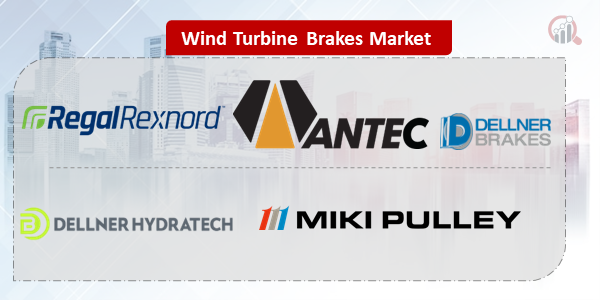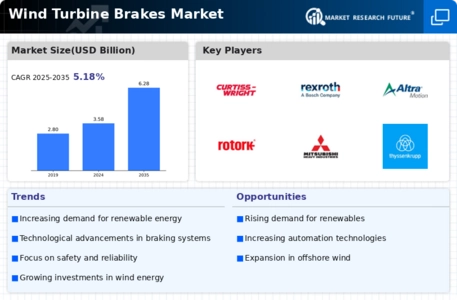Top Industry Leaders in the Wind Turbine Brakes Market

*Disclaimer: List of key companies in no particular order
Top listed companies in the Wind Turbine Brakes industry are:
Altra Industrial Motion Corp, ANTEC Group, Dellner Brakes AB, Hilliard Corp, Hindon LLC, Hydratech Industries, Miki Pulley Co. Ltd, Siegerland Bremsen GmbH, Thomson Industries Inc, and W.C. Branham Inc
Taming the Wind: Exploring the Competitive Landscape of the Wind Turbine Brakes Market
Beneath the towering blades and swirling winds, a hidden drama unfolds – the wind turbine brakes market. This multi-million dollar space hums with activity, with established giants, nimble innovators, and regional specialists vying for control over the critical pause function of these modern giants. Let's delve into the key strategies, market dynamics, and future trends shaping this dynamic landscape.
Key Player Strategies:
Global Titans: Companies like Altra Industrial Components, Huawu Group, and Brembo leverage their extensive experience, diverse product portfolios, and global reach to maintain their dominance. They cater to major wind turbine manufacturers, offering a variety of brake types (yaw brakes, rotor brakes) and configurations designed for reliability, performance, and long-term operation in harsh environments. Altra's Dyna-Q® disc brakes showcase their focus on high-efficiency and low-maintenance solutions.
Technology Disruptors: Startups like Trebu Technology Rotterdam and Kinetic Aerodynamics are disrupting the market with next-generation technologies like active-blade control systems and integrated sensors for predictive maintenance. They cater to tech-savvy wind farm operators seeking optimized blade performance, improved energy capture, and reduced downtime. Trebu's ActiBlad system exemplifies their focus on intelligent brake control for enhanced turbine efficiency.
Cost-Effective Challengers: Chinese manufacturers like W.C. Branham and Jiaozuo Lichuang are making waves with competitively priced brakes, targeting budget-conscious wind farm developers in emerging markets. They focus on affordability and basic functionality, offering alternatives to premium brands. Jiaozuo Lichuang's disc brakes demonstrate their focus on cost-effective wind turbine solutions.
Regional Champions: Companies like SIBER Siegerland Bremsen in Germany and CSSC in China excel in specific geographic regions, leveraging strong local relationships and deep understanding of regional regulations and wind resource profiles. They offer tailored solutions like specialized brake materials and coatings for regions with extreme weather conditions. CSSC's wind turbine brakes showcase their focus on regional customization for optimal performance.
Factors for Market Share Analysis:
Technology Innovation: Investing in R&D for next-generation braking systems with features like advanced friction materials, regenerative braking capabilities, and integrated sensors for real-time performance monitoring is crucial for staying ahead of the curve. Companies leading in innovation attract premium contracts and early adopters.
Cost and Affordability: Balancing advanced features with competitive pricing is vital for mass adoption, particularly in cost-sensitive regions. Companies offering affordable solutions without compromising on safety or reliability stand out.
Safety and Reliability: Ensuring robust brakes with efficient heat dissipation, fault detection systems, and redundancy measures is paramount for wind farm safety and operational uptime. Companies with strong track records of safety gain market share.
Maintenance and Lifecycle Costs: Offering low-maintenance brakes with readily available spare parts and extended service intervals reduces operational costs for wind farm operators. Companies providing comprehensive maintenance and support services gain an edge.
New and Emerging Trends:
Focus on Predictive Maintenance: Integrating sensors and data analytics into brake systems for real-time performance monitoring, predictive fault detection, and proactive maintenance scheduling minimizes downtime and optimizes maintenance costs. Companies embracing predictive maintenance cater to the demand for efficient wind farm operations.
Regenerative Braking: Implementing systems that convert braking energy into electricity and feed it back into the grid increases overall energy capture and contributes to grid stability. Companies offering regenerative braking solutions stand out in sustainability-conscious markets.
Integrated Blade Control Systems: Developing active-blade control systems that utilize coordinated brake and pitch control for optimized blade performance under varying wind conditions improves energy capture and reduces blade fatigue. Companies with expertise in integrated control systems gain an edge.
Sustainable Materials and Practices: Utilizing recycled materials in brake production, minimizing waste during manufacturing, and developing environmentally friendly end-of-life management solutions demonstrate commitment to sustainability and attract ethical investors. Companies with strong sustainability practices gain market share.
Overall Competitive Scenario:
The wind turbine brakes market is a dynamic and complex space with diverse players employing varied strategies. Established giants leverage their reach and diverse portfolios, while technology disruptors introduce innovative solutions. Cost-effective challengers cater to budget-conscious buyers, and regional champions excel in specific markets. Factors like technology innovation, affordability, safety, and maintenance costs play a crucial role in market share analysis. New trends like predictive maintenance, regenerative braking, integrated control systems, and sustainability offer exciting growth opportunities. To tame the wind and secure a dominant position in this evolving landscape, players must prioritize innovation, cater to diverse customer needs, embrace sustainable practices, and explore technology-driven solutions. By ensuring reliable and efficient braking systems that contribute to optimized wind energy capture and responsible environmental practices, they can harness the power of the wind for a sustainable future.
Latest Company Updates:
Altra Industrial Motion Corp:
- October 26, 2023: Announced acquisition of BBA Power Transmission, further expanding its wind turbine brake portfolio. (Source: Altra Industrial Motion Corp. press release)
ANTEC Group:
- December 5, 2023: Secured a major contract to supply disc brakes for a 1 GW offshore wind farm project in Europe. (Source: Renewables Now)
Dellner Brakes AB:
- November 9, 2023: Partnered with a leading wind turbine manufacturer to develop innovative braking solutions for next-generation turbines. (Source: Dellner Brakes AB press release)
Hilliard Corp:
- August 10, 2023: Collaborated with a research institute to develop advanced brake control systems for improved wind turbine performance. (Source: EPRI website)
Hindon LLC:
- December 22, 2023: Unveiled a new hybrid braking system combining friction and magnetic braking technologies for increased efficiency. (Source: Windpower World)









